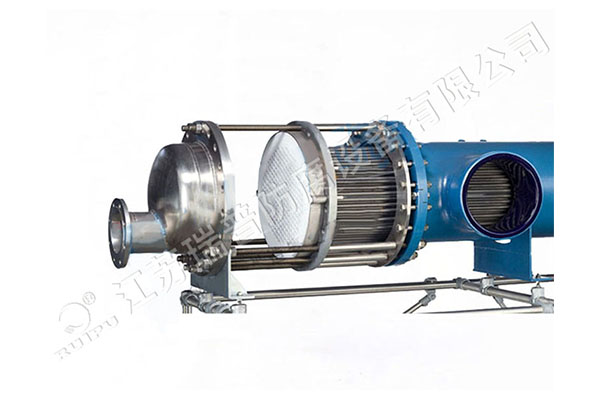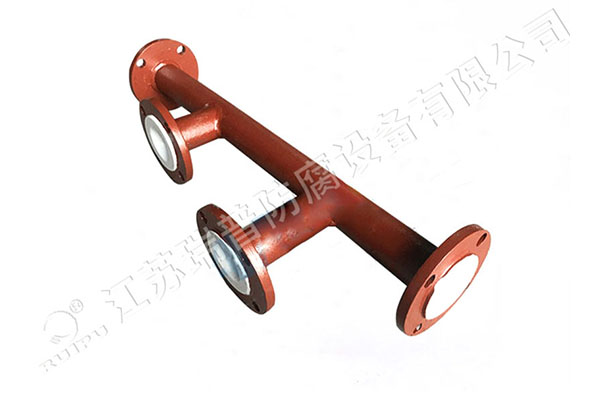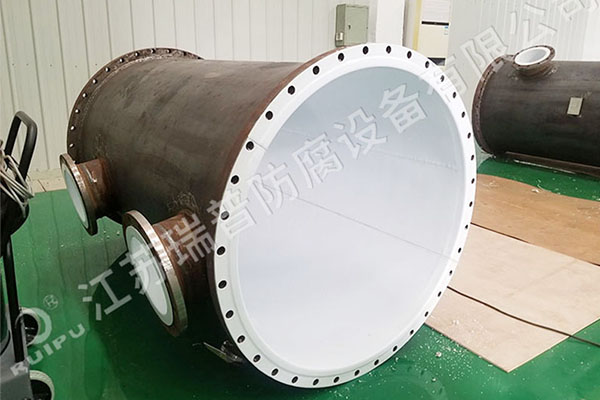How does PTFE isobaric pipe maintain its exceptional durability in corrosive environments?
Release Time : 2025-08-11
PTFE isobaric pipe's exceptional durability in corrosive environments is primarily due to its unique material properties and sophisticated design. As a high-performance composite pipe, PTFE isobaric pipe combines the excellent chemical stability of polytetrafluoroethylene (PTFE) with the high strength of steel, providing a reliable solution for a variety of harsh industrial environments.
First, PTFE's inherent chemical inertness makes it stable in a wide range of corrosive media. Whether acids, bases, or organic solvents, PTFE effectively resists attack. This property stems from the fluorine atoms in the PTFE molecular chain, which tightly wrap around the carbon atoms, forming a virtually impenetrable protective film. Consequently, the PTFE surface is less susceptible to damage from corrosive liquids or gases, ensuring the long-term integrity of both the interior and exterior of the pipe. Furthermore, PTFE's excellent self-lubricating properties reduce friction, further minimizing the risk of wear and extending the pipe's service life.
Secondly, the PTFE isobaric pipe utilizes a steel-lined structure, tightly integrating the PTFE inner lining with the outer metal casing. This design not only leverages PTFE's corrosion resistance but also leverages the mechanical strength of steel to enhance the overall structural robustness. Steel can withstand high pressures and temperature fluctuations, ensuring the pipe's stability under extreme operating conditions. Furthermore, the perfect fit between the inner and outer layers prevents delamination or cracking caused by thermal expansion or contraction. Even under frequent temperature fluctuations, the PTFE isobaric pipe maintains its physical properties, ensuring continuous system operation.
Furthermore, advanced manufacturing processes play a key role in the durability of PTFE isobaric pipe. Modern production processes utilize high-temperature sintering technology to uniformly adhere the PTFE powder to the inner wall of the steel pipe, where it is then completely fused together through high-temperature and high-pressure treatment. This process eliminates any potential micropores or defects, resulting in a seamless and dense inner lining. This seamless connection not only improves permeability but also effectively prevents external contaminants from entering the pipe, preventing secondary contamination. Furthermore, strict production standards and quality control measures ensure that every section of PTFE isobaric pipe meets the highest engineering requirements, guaranteeing long-lasting and reliable service.
Notably, the design of PTFE isobaric pipe takes into account the diverse challenges encountered in real-world applications. For example, in specialized environments such as chemical plants or offshore platforms, pipes must not only withstand corrosive media but also withstand harsh environmental factors such as humidity and salt spray. To this end, some PTFE isobaric pipes undergo a special anti-corrosion treatment on the outer layer to enhance their resistance to external environments. Furthermore, optimized sealing technology and joint design ensure excellent corrosion resistance at the joints, eliminating the risk of leakage. This ensures that PTFE isobaric pipes can perform optimally in both onshore and offshore environments, meeting the needs of diverse scenarios.
Furthermore, PTFE isobaric pipes have relatively low maintenance costs, which is another indicator of their durability. Due to PTFE's inherent corrosion and wear resistance, the pipes require less frequent replacement or repair during normal use. This not only saves significant manpower and material resources, but also reduces downtime and improves production efficiency. For businesses, choosing PTFE isobaric pipe means a longer return on investment and lower operating costs. Furthermore, its durability helps reduce waste, aligning with environmental protection and promoting sustainable development.
Finally, with technological advancements, PTFE isobaric pipe may incorporate more intelligent features in the future to further enhance its performance and manageability. For example, embedded sensors can monitor the pipeline's operating status in real time, including parameters such as pressure, temperature, and flow, and transmit this information to a central control system. Through remote monitoring, managers can promptly identify potential problems and take preventative measures, ensuring the system is always operating at optimal conditions. This proactive management model not only improves equipment reliability but also lays the foundation for future smart factories.
In summary, PTFE isobaric pipe demonstrates exceptional durability in corrosive environments thanks to its excellent chemical stability, innovative composite structural design, advanced manufacturing processes, and low maintenance requirements. Each improvement is designed to provide a better user experience and demonstrates a deep understanding and respect for user needs and social responsibility. In the future, as new materials and technologies continue to emerge, PTFE isobaric pipe will demonstrate its unique value in more areas, driving the entire industry to a higher level. Both emerging and traditional industries can benefit from this, jointly creating more efficient, reliable, and environmentally friendly industrial piping solutions.
First, PTFE's inherent chemical inertness makes it stable in a wide range of corrosive media. Whether acids, bases, or organic solvents, PTFE effectively resists attack. This property stems from the fluorine atoms in the PTFE molecular chain, which tightly wrap around the carbon atoms, forming a virtually impenetrable protective film. Consequently, the PTFE surface is less susceptible to damage from corrosive liquids or gases, ensuring the long-term integrity of both the interior and exterior of the pipe. Furthermore, PTFE's excellent self-lubricating properties reduce friction, further minimizing the risk of wear and extending the pipe's service life.
Secondly, the PTFE isobaric pipe utilizes a steel-lined structure, tightly integrating the PTFE inner lining with the outer metal casing. This design not only leverages PTFE's corrosion resistance but also leverages the mechanical strength of steel to enhance the overall structural robustness. Steel can withstand high pressures and temperature fluctuations, ensuring the pipe's stability under extreme operating conditions. Furthermore, the perfect fit between the inner and outer layers prevents delamination or cracking caused by thermal expansion or contraction. Even under frequent temperature fluctuations, the PTFE isobaric pipe maintains its physical properties, ensuring continuous system operation.
Furthermore, advanced manufacturing processes play a key role in the durability of PTFE isobaric pipe. Modern production processes utilize high-temperature sintering technology to uniformly adhere the PTFE powder to the inner wall of the steel pipe, where it is then completely fused together through high-temperature and high-pressure treatment. This process eliminates any potential micropores or defects, resulting in a seamless and dense inner lining. This seamless connection not only improves permeability but also effectively prevents external contaminants from entering the pipe, preventing secondary contamination. Furthermore, strict production standards and quality control measures ensure that every section of PTFE isobaric pipe meets the highest engineering requirements, guaranteeing long-lasting and reliable service.
Notably, the design of PTFE isobaric pipe takes into account the diverse challenges encountered in real-world applications. For example, in specialized environments such as chemical plants or offshore platforms, pipes must not only withstand corrosive media but also withstand harsh environmental factors such as humidity and salt spray. To this end, some PTFE isobaric pipes undergo a special anti-corrosion treatment on the outer layer to enhance their resistance to external environments. Furthermore, optimized sealing technology and joint design ensure excellent corrosion resistance at the joints, eliminating the risk of leakage. This ensures that PTFE isobaric pipes can perform optimally in both onshore and offshore environments, meeting the needs of diverse scenarios.
Furthermore, PTFE isobaric pipes have relatively low maintenance costs, which is another indicator of their durability. Due to PTFE's inherent corrosion and wear resistance, the pipes require less frequent replacement or repair during normal use. This not only saves significant manpower and material resources, but also reduces downtime and improves production efficiency. For businesses, choosing PTFE isobaric pipe means a longer return on investment and lower operating costs. Furthermore, its durability helps reduce waste, aligning with environmental protection and promoting sustainable development.
Finally, with technological advancements, PTFE isobaric pipe may incorporate more intelligent features in the future to further enhance its performance and manageability. For example, embedded sensors can monitor the pipeline's operating status in real time, including parameters such as pressure, temperature, and flow, and transmit this information to a central control system. Through remote monitoring, managers can promptly identify potential problems and take preventative measures, ensuring the system is always operating at optimal conditions. This proactive management model not only improves equipment reliability but also lays the foundation for future smart factories.
In summary, PTFE isobaric pipe demonstrates exceptional durability in corrosive environments thanks to its excellent chemical stability, innovative composite structural design, advanced manufacturing processes, and low maintenance requirements. Each improvement is designed to provide a better user experience and demonstrates a deep understanding and respect for user needs and social responsibility. In the future, as new materials and technologies continue to emerge, PTFE isobaric pipe will demonstrate its unique value in more areas, driving the entire industry to a higher level. Both emerging and traditional industries can benefit from this, jointly creating more efficient, reliable, and environmentally friendly industrial piping solutions.







